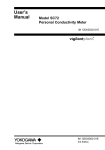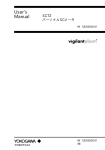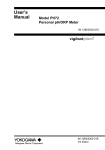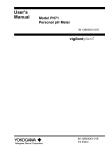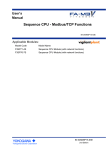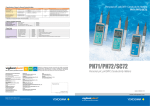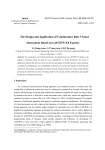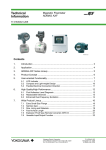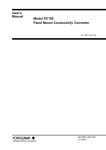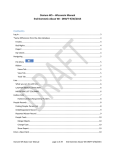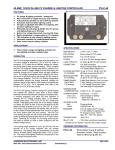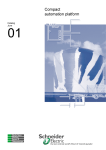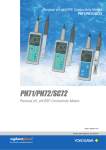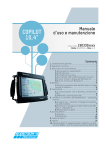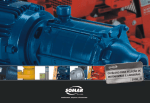Download User`s Manual
Transcript
User’s Manual Model SC72 Personal Conductivity Meter IM 12D03D02-01E IM 12D03D02-01E 1st Edition Preface Preface Before using the Model SC72 Personal Conductivity Meter, read this manual thoroughly. For safe use of this meter, the meter and the instruction manual include the following symbol marks. WARNING : CAUTION : Indicates that serious injury may result, if users fail to follow instruction manual procedures. Indicates that minor injury to personnel, or serious damage to the product, may result if users fail to follow procedures in the instruction manual. WARNING Do NOT use this instrument where there is a danger of electrical shock. Do NOT touch any part of the electrode immediately after measuring very hot liquids — otherwise, you may get burnt. CAUTION If the meter will not be used for an extended period of time, be sure to remove the battery. Otherwise battery leakage may occur, and may cause damage to the meter or cause erroneous meter operation. The contents of this manual are subject to change without prior notice. Yokogawa Electric Corporation assumes no liability for damage, defects, or loss of the product caused by any of the following: User error; Inappropriate or out-of-specifications use of the product; Use in an unsuitable environment; Repair or modification of this or related products by persons other than Yokogawaauthorized engineers. IM 12D03D02-01E 1st Edition: Aug. 2004 (YK) All Rights Reserved, Copyright © 2004, Yokogawa Electric Corporation 1 Preface Liquid crystal display (LCD) display characters The numeric LCD display is used to mimic alphabetic characters, as shown below: Alphabet Display Alphabet Display Numerals A N 0 B O 1 C P 2 D Q 3 E R 4 F S 5 G T 6 H U 7 I V 8 9 J W K X L Y M Z Display All display elements shown ON F00.EPS Note Regarding Panels Shown in this Manual: Panels shown in this manual should be regarded as examples. Actual panel format may vary depending on parameter settings and on type of connected sensor. Showing all display elements lit Display (gray represents flashing state) Flashing state: 2 Lit state: IM 12D03D02-01E Preface Warranty and Service Yokogawa products and parts are guaranteed to be free from defects in workmanship and materials under normal use and service for a period of (typically) 12 months from the date of shipment from the manufacturer. Individual sales units may offer different warranty periods, so the original purchase order should be consulted for the conditions of sale. Damage caused by normal wear and tear, inadequate maintenance, corrosion, or due to chemical processes, is excluded from this warranty coverage. In the event of a warranty claim, any items that are considered to be defective should be sent (freight paid) for repair or replacement (at Yokogawa discretion) to the service department of the relevant sales unit. The following information must be included in a letter accompanying the returned items: Model code and serial number Copy of original purchase order showing the date Length of time used, and the measuring environment Fault symptoms, and circumstances of failure Statement whether service under warranty or out-of-warranty service is requested Complete shipping and billing instructions for return of goods, plus the name and phone number of a contact person who can be reached for further information Goods that have been in contact with process fluids must be decontaminated / disinfected before shipment, and a statement to this effect should be included. Safety data sheets for all process components that the goods have exposed to should also be included. IM 12D03D02-01E 3 Contents CONTENTS Preface ...................................................................................................................... 1-1 1. Outline ................................................................................................................. 1-1 1.1 1.2 1.3 1.4 1.5 1.6 1.7 1.8 Features ......................................................................................................................... Personal Conductivity Meter Specifications .................................................................. When You Receive This Conductivity Meter ................................................................. Contents of Model SC72 Personal Conductivity Meter Package ................................. Component Names and Functions ................................................................................ Sensor Part Names and Functions ............................................................................... Options (Available Separately) ...................................................................................... Spare Parts .................................................................................................................... 1-1 1-2 1-3 1-4 1-5 1-6 1-8 1-8 2. Preparation .......................................................................................................... 2-1 2.1 2.2 2.3 2.4 2.5 2.6 Installing the Batteries ................................................................................................... Connecting Sensor Cable .............................................................................................. Setting Date and Time ................................................................................................... Setting Temperature Unit .............................................................................................. Setting Cell Constant ..................................................................................................... Setting Temperature Compensation Coefficient ........................................................... 2-1 2-2 2-3 2-4 2-4 2-6 3. Measurement ...................................................................................................... 3-1 3.1 3.2 3.3 3.4 Precautions .................................................................................................................... Measurement Procedures ............................................................................................. Measurement Panel ....................................................................................................... Saving Measured Value ................................................................................................ 3-1 3-2 3-3 3-3 4. Keyswitch Functions .......................................................................................... 4-1 4.1 Names and Functions of Keys ...................................................................................... 4-2 4.2 Liquid Crystal Display and Display Items ...................................................................... 4-4 4.3 Function Modes ............................................................................................................. 4-5 5. Handling of the SC72 Personal Conductivity Meter ........................................ 5-1 5.1 5.2 5.3 5.4 5.5 Tips to Maintain Meter Performance ............................................................................. Washing the Electrode .................................................................................................. Cleaning and Drying Connector .................................................................................... Calibration with Standard Solution ................................................................................ Storage and Maintenance ............................................................................................. 5-1 5-2 5-3 5-4 5-7 6. Troubleshooting ................................................................................................. 6-1 6.1 6.2 6.3 6.4 Causes of Abnormal Conductivity Display .................................................................... Error Messages and Corrective Action ......................................................................... Causes of Abnormal Measured Value .......................................................................... Other conditions ............................................................................................................. 6-1 6-2 6-4 6-4 7. Measuring Principles of this Instrument .......................................................... 7-1 7.1 7.2 7.3 7.4 What Is Conductivity? .................................................................................................... Principles of Operation .................................................................................................. Temperature Compensation and Finding Temperature Compensation Coefficient ..... Wetted Part Materials of Sensors ................................................................................. 7-1 7-2 7-3 7-4 Appendix ..................................................................................................................... 1 Revision Record .......................................................................................................... i 4 IM 12D03D02-01E 1. Outline 1. Outline The Model SC72 Personal Conductivity Meter is an accurate, portable, easy-to-use conductivity meter. It includes not only self-diagnostic functions, to help ensure validity of readings, but also data storage functions to allow users to check past data. The meter is of waterproof construction so that it can safely be used outdoors on a rainy day, and can also withstand being accidentally dropped into water. 1.1 Features Water resistant case When this meter is used with its dedicated sensor, it meets the requirements of class IP67 “Degree of Protection to be Provided by Enclosures” in IEC 60529. Wide measurement range, and convenient “Auto Range” function Sensors are available to cover measurement ranges between 0 to 2.000 mS/cm and 0 to 2 S/cm. Auto-range functions automatically set the optimum measurement range, making measurement easy. Automatic temperature compensation Automatic temperature compensation functions are provided for liquid measurement. Conductivity referenced to 258C can be obtained in solutions with temperature coefficients between 0.00 and 9.99%/8C. The temperature coefficients for NaCl solutions are already stored in the meter. Calendar and time functions Internal time functions allow “one-touch checking” of measurement date and time. Data storage function Up to 300 conductivities and temperature measurements, and their measurement date and time, can be saved. This function allows you to check past measurement data. Automatic power off function The meter will power off automatically if not operated during a preset time interval. The time interval can be set in one-minute increments in the range 1 to 120 minutes to meet your application requirements. This automatic power off function can also be disabled, but it is wise to leave it enabled to conserve the batteries. Simple alarm clock function The meter can issue an alarm signal at a specified time. Even when meter power is turned off, the internal clock can issue an alarm signal. Internal self-diagnostic functions display messages when appropriate. Bright easy-to view large LCD Displays liquid conductivity, liquid temperature, temperature coefficient, date and time. IM 12D03D02-01E 1-1 1. Outline 1.2 Personal Conductivity Meter Specifications Applicable measurement range: • Sensors for high purity water measurement (cell constant: 0.05 cm-1) Conductivity: 0 to 2mS/cm, 0 to 20mS/cm, 0 to 200mS/cm, 0 to 40MV•cm Temperature: 0 to 808C • For general-purpose sensors (cell constant: 5 cm-1) Conductivity: 0 to 20mS/cm, 0 to 200mS/cm, 0 to 2mS/cm, 0 to 20mS/cm, 0 to 200mS/cm, Temperature: 0 to 808C • For chemical-corrosion-resistant sensors (cell constant: 5 cm-1) Conductivity: 0 to 20mS/cm, 0 to 200mS/cm, 0 to 2mS/cm, 0 to 20mS/cm, 0 to 200mS/cm Temperature: 0 to 808C • Sensors for high-conductivity measurement (cell constant: 50 cm-1) Conductivity: 0 to 2mS/cm, 0 to 20mS/cm, 0 to 200mS/cm, 0 to 2S/cm Temperature: 0 to 808C Resolution: Conductivity: Temperature: Least significant digit: 1 digit; 0.18C Repeatability (Conductivity): 62% (65% for general-purpose sensor on 0 to 200mS/cm measurement range) Accuracy (Temperature): 60.78C (in the range 0 to 708C) 618C (when exceeding 708C) Temperature compensation range: variable 0.00 to 9.99%/8C, also (preset) NaCl solution temperature coefficient Measurement converted to conductivity at standard temperature of 258C Measured liquid temperature: 0 to 808C (0 to 508C when the sensor cable is immersed in water) Ambient temperature:0 to 508C Construction: IEC 60529, IP67 class of protection from environment Power requirement: Two of size AA batteries (LR6) Automatic power off interval: May be set in range 1 to 120 minutes Battery life: About 200 hours of continuous use, for long-life alkaline battery (life may vary depending on battery type and ambient conditions) External dimensions: Approximately 150 (H) x 61 (W) x 42 (D) mm (not including protruding portions) Weight: 1-2 Approximately 220 g (including batteries) IM 12D03D02-01E 1. Outline 1.3 When You Receive This Conductivity Meter Confirm that all SC72 meter package components (refer to Contents of Model SC72 Personal Conductivity Meter Package in Section 1.4 and sensor models described in Sec. 1.6, “Sensor Part Names and Functions.”) have been received. Carefully inspect the meter and sensor, referring to Section 1.5, “Component Names and Functions” when assembling meter and sensor. Particular attention should be taken: * Not to twist or force the cable. * Not to hit or drop the meter. * Not to get the sensor connector dirty. IM 12D03D02-01E 1-3 1. Outline 1.4 Contents of Model SC72 Personal Conductivity Meter Package Quick Manual 3 User's Manual Instrument Card 6 1 5 2 SC72 - - 4 - AA 7 9 8 10 11 11 SC72 - 11 - - AA *1 -23 -31 -41 Label language - -J -E - AA *1 - AA SC72 - 31 - Specification Personal conductivity meter Meter only, without sensor With sensor for high purity water measurement (cable length: 0.75m) With general-purpose sensor (cable length: 0.75m) With general-purpose sensor (cable length: 3m) With chemical-resistant sensor (cable length: 0.75m) With sensor for high-conductiivity measurement (cable length: 0.75m) Japanese English -AA Always -AA Model Suffix code SC72 Sensors -00 -11 -21 SC72 - 21 SC72 - 23 - 11 11 - AA *1 No. 1 2 3 4 5 6 7 8 9 10 11 SC72 - 41 - Name Personal conductivity meter Two dry batteries Two instruction manual Non-slip pads (two) Hand strap Instrument card Sensor for high purity water measurement General-purpose sensor Chemical-resistant sensor Sensor for high-conductivity measurement Sensor cleaner (five cotton swabs) *1 The meter model number and cell constants, as well as the sensor model no. (SC72SN-u-AA), are shown on the nameplate. 1-4 - AA *1 F010401.EPS IM 12D03D02-01E 1. Outline 1.5 Component Names and Functions O-ring Sensor cable connector Used to connect a dedicated conductivity sensor to the personal conductivity meter. Can attach hand strap here Display Displays conductivity, temperature, and temperature coefficient simultaneously. Battery box cover fixing screw Key switches PERSONAL SC METER MODEL SC72 STYLE S1.0 No. Instrument name plate with model number and serial number E000001 2004. F010501.EPS IM 12D03D02-01E 1-5 1. Outline 1.6 Sensor Part Names and Functions Four types of sensors are available for use with the Model SC72 Personal Conductivity Meter: (1) sensor for high purity water measurement (cell constant 0.05 cm-1), (2) general-purpose sensor (cell constant 5 cm-1), (3) chemical-resistant sensor (cell constant 50 cm-1), and (4) sensor for high-conductivity measurement (cell constant 50 cm-1). Check the model number and cell constant on the name plate to confirm which type of sensor you have. Model number and cell constants display plate example MODEL SC72SN CELL CONST SUFFIX -11-AA NO. 000001 Cell constants STYLE S1.0 Made in Japan SC72SN Conductivity sensors for personal conductivity meter Model Suffix code Specification Remarks *2 Conductivity sensor for personal conductivity meter SC72SN For SC72; for high purity water measurement (cable -11 length: 0.75m) For SC82; for high purity water measurement (cable -19 K9221XB length: 0.75m) *1 For SC72; for general purpose type (cable length: 0.75m) -21 For SC72; for general purpose type (cable length: 3m) -23 1 For SC82; for general purpose type (cable length: 0.75m)* K9221XA -29 For SC72; for chemical-resistant type (cable length: -31 0.75m) For SC82; for chemical-resistant type (cable length: -39 K9221XC 0.75m) *1 For SC72; for high conductivity measurement (cable -41 length: 0.75m) For SC82; for high conductivity measurement (cable K9221XD -49 length: 0.75m) *1 -AA Always -AA *1: Waterproofing is not guaranteed if you use SC82-type conductivity sensor in conjunction with SC72 meter. F010601.EPS *2: Old part number for SC82 conductivity meter. 1-6 IM 12D03D02-01E 1. Outline Sensor for high purity water measurement SC72 - 11 - General-purpose sensor SC72 - 21 SC72 - 23 - - AA *1 Model number and cell constants display plate - AA - AA *1 Model number and cell constants display plate (SC72SN-11-AA) *1 (SC72SN-21-AA,*1 SC72SN-23-AA) Watertight cover Prevents moisture from entering connector and causing leakage between pins. Watertight cover Sensor cable Connector Connects sensor cable to conductivity meter Connector Sensor cable Sensor body Outer electrode connection (SUS316 stainless seel) Sensor grip Sensor grip Inner electrode (Titanium) Sensor body Inner electrode (SUS316 stainless seel) Plastic body can withstand temperatures up to 808C. Edge electrode (Titanium) Outer electrode (SUS316 stainless seel) Cover (Plastic) F010602.EPS Chemical-resistant sensor SC72 - 31 - - AA Sensor for high-conductivity measurement *1 SC72 - 41 - - AA *1 Model number and cell constants display plate Model number and cell constants display plate (SC72SN-41-AA) *1 (SC72SN-31-AA) *1 Watertight cover Watertight cover Sensor cable Connector Sensor cable Connector Sensor grip Air vent Sensor grip Air vent Sensor body (glass) Sensor body (glass) Inner electrode (platinum black) Inner electrode (platinum black) *1 SC72SN-u will be described on sensor's name plate for the model number. IM 12D03D02-01E F010603.EPS 1-7 1. Outline 1.7 Options (Available Separately) The following options are available for the Personal Conductivity Meter for your convenience. When ordering, specify part number shown below. Standard solution (Part no.: K9221ZA) Soft case (Part no.: B9269KJ) Sensor stand (Part no.: K9220XN) Approx. 280 Unit: mm 0 Appro 0.1mol/l NaCl solution for calibration (250ml) .3 rox x. 140 App This soft black carrying case holds conductivity meter and sensor. This stand holds the sensor when the conductivity meter is used on a table. It is made of rustproof stailess steel. F010701.EPS 1.8 Spare Parts O-rings and gaskets are important parts to ensure that the SC72 meter is water resistant. Replace these parts as required. Refer to Section 5.5, “Storage and Maintenance” for replacement. O-ring and gasket set (Part no.: K9654AY) Two battery box gaskets Two sensor connection O-rings F010801.EPS 1-8 IM 12D03D02-01E 2. Preparation 2. Preparation 2.1 Installing the Batteries Install the batteries first. CAUTION Select a relatively moisture-free location when installing batteries in the meter. When installing batteries, observe correct polarity (battery orientation). Failure to do so may damage to the meter. Remove batteries from the meter if it is to be stored for an extended period of time. Do not leave dead batteries in the meter. They may leak and cause meter failure or erratic operation of the meter. When replacing batteries, replace both batteries at the same time. If only one battery is replaced, the new battery may discharge into the old battery, which may leak chemicals and damage the meter. If the battery box gasket is damaged or dirty then the unit may no longer be waterproof; replace the gasket in this case. (1) Loosen the battery box cover with a coin or the like. (2) Remove battery cover and install batteries as shown in figure. (3) Check for foreign material on sealing gasket around battery box. (4) Secure tip of battery box cover in the battery box and close the cover. Gasket (5) Tighten the battery box cover with a coin or the like. F020101.EPS IM 12D03D02-01E 2-1 2. Preparation 2.2 Connecting Sensor Cable Connect the sensor cable as shown below. CAUTION Select a relatively moisture-free location when connecting the sensor cable. Take care not to wet or dirty the connector when connecting the sensor cable. Model SC82 sensors can be connected, but these are not guaranteed to be waterproof when used with this meter. (2) (1) Pull the waterproof cover along the sensor cable away from the Locknut connector to expose the locknut. (2) Connect the connector to the meter (1) body*, and tighten the locknut firmly so that it won't come loose. * Align sensor connector with sensor body connector. Waterproof cover O-ring (4) (3) (3) Move the waterproof cover towards the connector until it firmly contacts the O-ring on the meter body. * Align sensor connector with sensor body connector. (4) Next turn the cover 90 degrees in the direction shown in the figure to lock it. F020201.eps Caution:It is recommended that, as far as possible, you leave the sensor connected to the meter to help ensure that the connector does not get dirty. 2-2 IM 12D03D02-01E 2. Preparation 2.3 Setting Date and Time After installing the batteries, set the date and time. Note that if the power is turned off after setting “minutes,” start with the date setting when you turn on the power next time. If you replace the batteries, the date is not affected, but the time is reset. Reenter the time. Caution:If the sensor is not connected then an error will be displayed on the meter. • Setting method After installing batteries, press and hold the POWER key for at least one second. Then all display elements turn on and the date setting display automatically appears. Set year, month, day, hours, and minutes as follows: Caution:If you stop part way through the date and time setting then the meter will beep and the date and time will not be updated. After POWER key for at least 1 sec. pressing Month setting Year setting to set After several seconds F/ENT to confirm to set Day setting F/ENT to confirm Minute setting Hour setting (24-hour format) to set to set F/ENT F/ENT to confirm to confirm to set After several seconds F/ENT to confirm or F020301.EPS IM 12D03D02-01E 2-3 2. Preparation 2.4 Setting Temperature Unit Default temperature units are 8C. To change to 8F, refer to Sec. 4.3 (13) Set temperature units (tP.U) panel. 2.5 Setting Cell Constant Even for sensors of the same type, each sensor has its own distinct cell constant. So, set the proper cell constant as indicated on the sensor cable. Whenever sensors are replaced, be sure to change the cell constant setting in the meter accordingly. Cell constants once set are stored in non-volatile memory and are not lost even when the batteries are replaced. • Setting cell constants Press the F/ENT key to switch to function mode. Then select the C.C display with the key and access the cell constant setting display with the key to set the cell constant, then press the F/ENT F/ENT key. Use the key to confirm it. Refer to Sec. 4.3 (4). 2-4 IM 12D03D02-01E 2. Preparation F/ENT for Function mode select C.C F/ENT for C.C panel to enter C.C F/ENT MEAS F020501.EPS You can abort this procedure at any time by pressing MEAS to revert to measurement mode. IM 12D03D02-01E 2-5 2. Preparation 2.6 Setting Temperature Compensation Coefficient As described in Section 7.3, liquid conductivity varies with liquid temperature. Therefore, if concentration is measured by conductivity, the conductivity must be converted to equivalent conductivity at a certain temperature. This instrument incorporates standard temperature conversion functions to convert liquid conductivity measurements to equivalent conductivity at 258C. To display equivalent liquid conductivity at 258C, set the temperature compensation coefficient as described in this section. Temperature coefficient for NaCl solutions is stored in this instrument. If any other solution is used, set the temperature compensation coefficient manually. Refer to Sec. 4.3 (2) Temperature compensation setting (t.Co) panel. 2-6 IM 12D03D02-01E 2. Preparation • Set the temperature compensation coefficient F/ENT for Function mode select t.Co F/ENT for t.Co panel For NaCl solutions Manual setting select NaCl or %/8C (%/8F) F/ENT Set the temperature compensation coefficient with the keys. F/ENT F/ENT MEAS MEAS The temperature coefficient you set is displayed here IM 12D03D02-01E F020601.EPS 2-7 2. Preparation 2-8 IM 12D03D02-01E 3. Measurement 3. Measurement 3.1 Precautions (1) Be sure to check that the cell constant and the temperature coefficient are set correctly. (2) Check that the plastic cover (for general-purpose sensor) and outer electrode (for high purity water measurement) are secure. (3) Do not use the SC72 meter to measure liquids with temperatures over 808C. (If the whole sensor including cable is immersed, liquid temperature shall be below 508C.) Do not use the meter to measure extremely corrosive liquids such as solutions of hydrofluoric acid. (4) Remove dirt and stains from the meter with soft tissue. If necessary, wipe the meter case with neutral detergent. (5) If any problem with the meter arises during measurement, refer to the Troubleshooting section later in this manual to determine the cause. (6) After finishing measurement, flush stains on the sensor and measured solutions with water, and store the meter (refer to Chapter 5, “Handling of the SC72 Personal Conductivity Meter”). When the meter is used on a table: The meter is designed as a portable instrument; however, to use it on a table, attach nonslip pads (supplied with the instrument) at top and bottom of the meter to stop it from moving when the sensor is moved. Non-slip pads PERSONAL SC METER M O DEL SC72 STYLE S1.0 N o. E00000 1 2004. F0301.EPS Figure 3.1 IM 12D03D02-01E Position of non-slip seats 3-1 3. Measurement 3.2 Measurement Procedures Dipping sensor into liquid To help avoid errors due to air bubbles around the sensor element (inner electrode), immerse the sensor into the liquid to be measured so that its air vent is below liquid level. To dislodge any air bubbles from the inner electrode, dip the sensor into the liquid and move it up and down two or three times. Air vent Measuring liquid level Cover Electrode element If air bubbles are on this section, measurement error may occur. F0302.EPS Figure 3.2 3-2 Dipping Sensor in Liquid (for general-purpose sensors) IM 12D03D02-01E 3. Measurement 3.3 Measurement Panel Immerse the sensor into the liquid to be measured to display the liquid conductivity on the LCD display. There are three measurement panel display types: the standard display, calendar, and clock display. MEAS Use the key to toggle the display type. Standard display Calendar display Clock display conductivity MEAS MEAS Measuring liquid temperature day month year Temperature compensation coefficient hour : minute MEAS This display appears when NaCl solution is specified at temperature compensation coefficient setting. F030301.EPS 3.4 Saving Measured Value The meter offers two ways of storing measured values: HOLD for temporary storage and non-volatile data storage that retains data even if batteries are removed. (1) HOLD If the HOLD key is pressed during measurement, the measured values are temporarily held (display no longer changes). Press the HOLD key or MEAS key to return to the measurement mode. HOLD HOLD IM 12D03D02-01E or MEAS F030401.EPS 3-3 3. Measurement (2) Data storage If the F/ENT DATA key is pressed during measurement, mark starts flashing. Press the key, then currently measured data can be stored in nonvolatile memory. Data stored are measured conductivity, measured temperature, date and time. Up to 300 data including individually deleted data can be stored. If you attempt to store more data, is displayed. If is displayed even though the number of data stored is less than 300, perform “defrag” [refer to Section 4.3 (15), “Defragment storaged data (DFLG) panel”]. By doing so, you can increase the number of data to be stored. To check stored past data, refer to 4.3 (1) dAt (display stored measurement value) later in this manual. While is flashing, press the DATA key or MEAS key to return to measurement mode without storing data. DATA Abort data storage. While is flashing, press DATA or MEAS keys to abort data storage. Execute data storage. Press 3-4 F/ENT key to store data while is flashing. F030402.EPS IM 12D03D02-01E 4. Keyswitch Functions 4. Keyswitch Functions There are seven membrane keys on the keyboard of the Personal Conductivity meter. The following key functions are provided. * Display the conductivity, measured temperature and temperature coefficient. * Display the conductivity, date and time. * Hold conductivity and temperature measurements. * Store conductivity and temperature measured data. * Other functions such as parameter setting. When meter is OFF, press for at least 1 sec. to turn on power. When meter is ON, press for about 2 sec. to turn off the power. Automatic Power OFF function default: 20 min. inactivity. If you press this key during measurement, mark is displayed, and present measured values are held. To return to MEAS mode, press HOLD or MEAS keys. If pressed during measurement, mark flashes. Press key to store measured values in memory. To abort data storage and return to MEAS mode, press DATA or MEAS key again while mark is flashing. F/ENT Auto Power Off POWER MEAS HOLD F/ENT DATA Press to start measurement mode. If already in MEAS mode, it switches the display panel. If pressed while in MEAS mode, switches to function mode. Also used to enter set value. Change set value. F040001.EPS IM 12D03D02-01E 4-1 4. Keyswitch Functions 4.1 Names and Functions of Keys POWER : Power ON/OFF key If nothing is displayed on the LCD, hold down this key for about one second or more to turn the power on. If something is displayed on the LCD, pressing and holding this key for about two seconds turns power off. If no keys are pressed during a certain time interval, power turns off automatically (refer to “A.oFF,” Set Auto Power Off Interval of Section 4.3 (10)). HOLD : HOLD key Press the HOLD key to hold the currently-displayed conductivity and temperature measurement values ( Press the and turn DATA HOLD key or mark turns on). MEAS key again to return to measurement mode mark off. : Data key When the meter is in measurement mode, pressing this key causes the mark to flash and the currently-displayed conductivity and temperature measurement values to be temporarily stored. Pressing the F/ENT key while the mark is flashing stores the data and returns to measurement mode. To abort data storage, press the DATA key or MEAS key again; the mark turns off and the meter returns to measurement mode. MEAS : Measurement key In measurement mode, pressing this key toggles between different LCD display types (refer to Section 3.2, “Measurement Procedures”). If this key is pressed while in any mode other than measurement mode, the instrument returns to measurement mode. If you want to cancel any operation, pressing this key returns you to measurement mode. : Setting change key Used to change settings. 4-2 IM 12D03D02-01E 4. Keyswitch Functions F/ENT : Entry key In measurement mode, pressing this key switches the meter to function mode (see Section 4.3, “Function Modes”). This key is also used to confirm set values. Buzzer (Beep) sound When a key is pressed, the buzzer beeps. Where the buzzer beeps once, or when it beeps three times continuously, the meaning is as follows: (1) When the buzzer beeps once: This means that key operation was accepted. (2) When the buzzer beeps three times continuously: This means that the key operation was not accepted. To disable the above key entry beep, refer to Sec. 4.3 (11) Set buzzer ON/OFF (bZ.o) panel. Note: the sound volume level of the beep cannot be adjusted by the user. IM 12D03D02-01E 4-3 4. Keyswitch Functions 4.2 Liquid Crystal Display and Display Items Displays and their explanations are shown below. Remaining battery life display Temp. compensation setting mode Manual range setting mode Data save mode HOLD mode Calibration with std. solution Cell constant set mode F040201.EPS (1) Remaining battery life display Remaining battery life is always displayed stepwise. When display is , battery is normal. When a flashing is displayed, battery power is low. Replace the batteries immediately if the above flashing battery symbol appears. Press POWER and confirm that display turns off, then refer to Sec. 2.1 for battery replacement procedure. (2) Temperature compensation setting mode This mark appears when temperature compensation is being set (refer to Temperature compensation setting (t.Co) panel in Section 4.3 (2)) (3) Manual range setting mode Normally autoranging is used, and optimum range is selected automatically, but if fixed (manual) range setting is used then this mark appears (refer to Range selection (rnG) panel in Section 4.3 (3)). (4) Data save mode This mark appears when measured data are stored or when already-stored data are accessed (see Operation of DATA key in Section 4.1, or Display stored measurement value in Section 4.3 (1)). (5) HOLD mode This mark appears while measured data are being temporarily held (refer to Operation of HOLD key in Section 4.1). (6) Calibration with standard solution This mode display appears when the calibration with standard solution is conducted (refer to Calibration with standard solution (CAL) panel in Section 4.3 (5)). (7) Cell constant set mode This mode display appears when the sensor cell constants are manually set (refer to Cell constant setting (C.C) panel in Section 4.3 (4)). 4-4 IM 12D03D02-01E 4. Keyswitch Functions 4.3 Function Modes Outline A variety of functions are supported by function mode. Press the F/ENT key to switch from measurement mode to function mode. This mode supports the functions listed in the table below. Note: The last selected and executed item is displayed when you switch to function mode. Pressing the keys displays the items listed in Table 4.1 in turn. Methods of setting items Use the the key to move to the desired item. While the desired item is flashing, press F/ENT key to set each item in detail. To return from the function mode to the measurement mode, press the Table 4.1 Item *1 MEAS key. Items set in function mode Default value *2 Details For detais, refer to: dAt Display stored measurement value no dAta Item (1) t.Co Temperature compensation setting 0.00 %/ 8C Item (2) rnG Range selection Auto C.C Cell constant setting Item (3) *3 Standard cell constant Item (4) CAL Calibration with standard solution 2 Item (5) dEL.A Delete all stored measuring data 2 Item (6) dAtE Date setting 2004, January, 1 Item (7) tIME Time setting 0 hour 0 minute Item (8) ALM Alarm time setting oFF Item (9) A.oFF Set Auto Power Off interval 20 min Item (10) bZ.o Set buzzer ON/OFF on Item (11) SC.U Set measurement unit S/cm Item (12) tP.U Set temperature unit 8C Item (13) VEr Version number display 2 Item (14) Defragment storaged data 2 Item (15) dFLG *1: Numeric display used to simulate alphabetic character display. *2: 2: This data is not user-settable *3: The standard cell constant for the connected sensor is displayed. IM 12D03D02-01E T0401.EPS 4-5 4. Keyswitch Functions Details about how to set each item are provided below. (1) Display stored measurement value (dAt) panel Used to display stored measurement values. mark appears in the top left corner of the display. The last-stored conductivity and temperature values are displayed first. The stored data item number flashes in the lower left corner. Pressing the DATA key displays the date and time of this stored data, and pressing this key again allows individual data to be deleted (refer to the figure next page). keys allows you to scroll through all past data. If no data are stored, Pressing “no dAtA” is displayed at the bottom of the display. • Individual deletion of stored data items After displaying date and time of this stored data, pressing the panel with dEL. Pressing the F/ENT DATA key displays a key on this panel switches to the Data Delete panel. First F/ENT is flashing, so use keys to switch to flashing , then press the key to delete the stored measurement data that is currently displayed. • Stored data item numbers after deletions When you display the dEL panel, the number displayed at the bottom left indicates the stored data number relative to the beginning of the data store. This does not necessarily represent the number of stored data. If you delete a data item, item numbers of data that follow it will be decreased by one (see explanation below). • Data display after deletion If a data item is deleted, the data item after it is displayed. If there is no data after it (i.e. it was the last stored data item, the data item before it (if any) is displayed. When data item 012 (lastest data) is deleted: Item 012 is deleted, so item 011 becomes the latest When data item 011 is deleted Item 011 is deleted, so item numbers of following items (only item 012 in this case) are decremented by 1. F040300.EPS 4-6 IM 12D03D02-01E 4. Keyswitch Functions F/ENT to display other data Dsy, month data was stored Stored measurement data DATA Year that data was stored DATA Latest data DATA "Delete stored data" panel DATA Time stored F/ENT DATA F/ENT Delete stored data F/ENT When no stored data. F/ENT F040301.EPS IM 12D03D02-01E 4-7 4. Keyswitch Functions (2) Temperature compensation setting (t.Co) panel This panel is used to change the temperature compensation type and temperature coefficient setting. The TEMP mark appears on the panel. • Automatic temperature compensation for NaCl solution Press the keys to select NaCl . Then press the F/ENT key. • Manual temperature compensation coefficient setting Press the keys to select %/8C (or %/8F). Then press the keys to set the temperature coefficient. Then press the key. Use the F/ENT F/ENT key. F/ENT Use keys to select F/ENT For NaCl: When NaCl is displayed, press F/ENT key to confirm. For manual setting: When %/8C (or %/8F) is displayed, set the temperature coefficient with keys. Press F/ENT key to complete the temperature coefficient setting. F040302.EPS 4-8 IM 12D03D02-01E 4. Keyswitch Functions (3) Range selection (rnG) panel Change the current measuring range. Use the keys to change between autoranging and fixed range. For fixed range, mark appears. Relationships between automatic and fixed ranges for different sensors For general-purpose sensor (SC72-21, -23) *1 For chemical-resistant sensor (SC72-31) *1 Autorange Autorange Fixed range 5 (0-20.00mS/cm) Fixed range 5 (0-20.00mS/cm) Fixed range 4 (0-200.0mS/cm) Fixed range 4 (0-200.0mS/cm) Fixed range 3 (0-2.000mS/cm) Fixed range 3 (0-2.000mS/cm) Fixed range 2 (0-20.00mS/cm) Fixed range 2 (0-20.00mS/cm) Fixed range 1 (0-200.0mS/cm) Fixed range 1 (0-200.0mS/cm) (Example) *1 For general-purpose sensor (SC72-21, -23) used with 0-200.0mS/cm F/ENT Press With sensor for high-conductivity measurement (SC72-41) *1 With sensor for high-purity water measurement (SC72-11) *1 key or key five times Fixed range 1 Autorange Autorange Fixed range 4 (0-2.000mS/cm) Fixed range 4 (0-40.0MVcm) Fixed range 3 (0-20.00mS/cm) Fixed range 3 (0-2.000mS/cm) Fixed range 2 (0-200.0mS/cm) Fixed range 2 (0-20.00mS/cm) Fixed range 1 (0-2.000S/cm) Fixed range 1 (0-200.0mS/cm) Refer to Relationships between automatic and fixed ranges... (above left) Autorange F/ENT Set range 1 fixed. *1: Model no. of sensor alone is SC72SN-u. (refer to Sec. 1.6) F040303.EPS IM 12D03D02-01E 4-9 4. Keyswitch Functions (4) Cell constant setting (C.C) panel This panel with the Use the mark is used to set the cell constant manually. keys to set the cell constant. Then press the F/ENT key. Typical cell constants are as follows: For pure water sensor (SC72-11): 0.05 cm-1 For general-purpose (SC72-21, -23) and chemical-resistant sensors (SC72-31): 5 cm-1 Sensors for high-conductivity measurement: 50 cm-1 When setting the cell constant, you should check the nameplate (attached to sensor cable) for the model number and cell constant. The cell constant can be set in the range 6 20% of standard cell constant. For example, for general-purpose sensors with standard cell constant of 5 cm-1, a cell constant ranging from 4.00 to 6.00 can be set. Once the cell constant is set, it remains stored in memory even when batteries are removed. The general-purpose cell has the same cell constant whether used with SC72-21 or SC7223 type. Refer to Sec. 2.4 for cell constant setting procedure. Use key to set the cell constant. Then press F/ENT the F/ENT key to complete setting. F040304.EPS 4-10 IM 12D03D02-01E 4. Keyswitch Functions (5) Calibration with standard solution (CAL) panel This panel is used for calibration with standard solution. Refer to Sec. 5.4 for a description of the calibration procedure. In CAL mode, the mark appears at the top of the panel and all digits of the present measurement value flash. After the measurement stabilizes, press the F/ENT key to display the measured value at that time. Only the least significant digit flashes. Use the calibration value, then press the F/ENT keys to set the desired key to complete the calibration. The meter internal cell constant is changed after completing calibration with standard solution. Referring to (4) cell constant setting (C.C) panel, confirm the updated cell constant value and rewrite the cell constant (refer to the value on the plate attached to the sensor cable. Rewritten cell constants remain even if batteries are removed. To abort calibration using standard solution, press the MEAS key to return to measurement mode. All digits of measurement value are flashing F/ENT Least significant digit is flashing F/ENT Press the F/ENT key to complete calibration. F040305.EPS IM 12D03D02-01E 4-11 4. Keyswitch Functions (6) Delete all stored measuring data (dEL.A) panel This panel is used for deleting all stored data. When you switch to this panel, Press the F/ENT is flashing. Use the keys to select . key to delete all the data completely. F/ENT to set F/ENT to abort F/ENT to execute delete all F040306.EPS (7) Date setting (dAtE) panel Set the date for the meter; year (four digits), month, day in order. Use the keys to set year, month, and day. Then press the key to complete F/ENT setting. Year setting Month setting F/ENT F/ENT F/ENT Day setting F/ENT F040307.EPS The calendar functions will be correct through to the year 2090. 4-12 IM 12D03D02-01E 4. Keyswitch Functions (8) Time setting (tIME) panel For the converter, set the time (24-hour display), minutes in order. Use the keys to set hours and minutes. Then press the F/ENT key to complete setting. Hour setting (24-hr clock) Minute setting F/ENT F/ENT F/ENT F040308.EPS IM 12D03D02-01E 4-13 4. Keyswitch Functions (9) Alarm time setting (ALM) panel Alarm Enable (ON) / Disable (OFF) and alarm occurrence time (hours and minutes) can be set. Use the keys to set alarm time. Alarm time setting methods are the same as for (8) Time setting (tIME). Alarms sounds for about 15 seconds continuously. Acknowledge alarm by pressing any key to stop alarm sound. If no key is pressed to acknowledge the alarm occurrence, alarms sound for 15 seconds again three and six minutes after the preset alarm time. Note: The day of the week is not displayed F/ENT Hour setting (24-hr clock) alarm sounds at preset time F/ENT every day F/ENT Minute setting alarm sounds at preset time from Monday to Friday alarm sonds once at preset time F040309.EPS 4-14 IM 12D03D02-01E 4. Keyswitch Functions (10) Set Auto Power Off interval (A.oFF) panel Set the time interval for the power to turn off automatically if no key is pressed during a preset time interval. The Interval can be set to between 1 and 120 minutes. If “0 minutes” is set, automatic power OFF functions are disabled, so — without some care — batteries won’t last very long. Use key to set F/ENT to confirm F/ENT F040310.EPS (11) Set buzzer ON/OFF (bZ.o) panel This panel is used to enable or disable the beep (“buzzer”) that sounds when keys are pressed. Use the keys to enable / disable. Then press the F/ENT key to complete setting. Note this function does not disable the Time Alarm sound in (9) above. F/ENT F/ENT to turn ON (enable). F/ENT to turn OFF (disable). F040311.EPS IM 12D03D02-01E 4-15 4. Keyswitch Functions (12) Set measurement unit (SC.U) panel Toggle the measurement value units between [S/cm] and [S/m]. Use the keys to toggle the measurement value units. Then press the key F/ENT to complete setting. F/ENT to toggle F/ENT to set F040312.EPS (13) Set temperature unit (tP.U) panel Toggle the temperature units between [8C] and [8F]. Use the keys to toggle the temperature units. Then press the F/ENT key to complete setting. F/ENT to toggle F/ENT to set F040313.EPS 4-16 IM 12D03D02-01E 4. Keyswitch Functions (14) Version number dispaly (VEr) panel Displays program firmware version number. Can’t be set by the user. F/ENT F040314.EPS IM 12D03D02-01E 4-17 4. Keyswitch Functions (15) Defragment storaged data (dFLG) panel Up to 300 data can be stored. Unnecessary data can be individually deleted as in (1) Stored measurement data panel (dAt). At the same time, individual deletion does not free up memory occupied by deleted data, so may be displayed even though less than 300 data are stored. In such a case, use defrag functions to compact storage and free up the space occupied by deleted data, thereby allowing up to 300 data to be stored. While data defrag is in progress, do NOT turn off the power. In addition, before starting data defrag, check that the battery power is normal to avoid battery voltage dropout during defrag. • Performing data defrag If the F/ENT Use the key is pressed from the display shown below, keys to select , then press the F/ENT flashes. key. While defrag is in progress, [WAIt] flashes (Note: if only a few data are deleted, you may not even see it). When defrag is complete, [End] is displayed. F/ENT to toggle to confirm F/ENT to abort F/ENT to execute (if only a few data are deleted, you may not see this) After a few seconds F040315.EPS 4-18 IM 12D03D02-01E 5. Handling of the SC72 Personal Conductivity Meter 5. Handling of the SC72 Personal Conductivity Meter 5.1 Tips to Maintain Meter Performance The SC72 meter appears to be very simple, but is a precision instrument. To ensure that measurement accuracy is maintained, observe the following precautions regarding preliminary setting, measurement, maintenance and storage. Preliminary setting, measurement, maintenance and storage: Measurement Preliminary setting Maintenance Storage F050101.EPS Table 5.1 Observe the following precautions Setting cell constant • Set specific electrode cell constant. Preliminar y setting Setting temperature coefficient • Set liquid temperature coefficient when the standard temperature conversion is required (see Section 2.5) If standard temperature conversion is not requiresd, set 0.00. • Select one of the three conductivity measurement ranges (0 to Measurement 200mS/cm, 0 to 200mS/cm, or 0 to 2S/cm) corresponding to the type of electrode used. Temperature measuring range is 0 to 808C. • When measurement is completed, thoughly wash electrode to remove the Maintenenace measured liquid. • If the electrode gets stained or deformed, its cell constant may change. In this case, calibrate the meter with standard solution (see Section 5.4). Storag e • Avoid high-temperature, high-humidity storage locations. T0501.EPS IM 12D03D02-01E 5-1 5. Handling of the SC72 Personal Conductivity Meter 5.2 Washing the Electrode Dirt or stains on the electrode may have an adverse effect on the cell constant, thereby making accurate conductivity measurement impossible. Therefore, after measurement, rinse the electrode in clean water (for example, tap water) to remove stains. Even if staining is not apparent, the sensor performance may have changed. If so, wash the electrode by moving the sensor up and down in hydrochloric acid (about 0.1 mol/l) or water with a little neutral detergent dissolved in it. [For general-purpose and pure-water sensors: if the electrodes are difficult to clean, wipe them gently from top to bottom with a cotton wool swab.] After cleaning the electrode, rinse it in water. • General-purpose sensor (The figure below shows the general-purpose sensor with the cover removed). Remove the cover, and wipe stains off the electrodes (inner electrode and tip element) with a cotton swab. Rinse in a cleaning solution consisting of water containing a little neutral detergent, to remove stains from the electrode. After cleaning, wipe the electrode element (inner and edge electrodes) with tissue paper or cotton wool. Inner electrode (titanium) Edge electrode (titanium) F050201.EPS • Sensor for high-purity water measurement Remove the reference electrode part, and wipe the electrode elements (the shaded parts in the figure) with tissue paper or cotton wool. Cotton wool swab Internal electrode Reference electrode contact Reference electrode F050202.EPS * Corrosion-resistant sensors and sensors for high-conductivity measurements Use a beaker or the like containing water, dilute hydrochloric acid, or weak neutral detergent; move the sensor up and down so it is immersed up to the air vent, and wash in tap water to clean out the air vent. 5-2 IM 12D03D02-01E 5. Handling of the SC72 Personal Conductivity Meter 5.3 Cleaning and Drying Connector If there is an electrical path between the connector pins, solution conductivity cannot be measured correctly. Clean the connector (shown in the figure) with a dry cloth, or a cloth moistened with pure undiluted alcohol, to remove moisture and/or stains. If necessary, use a hair dryer to dry any section that is likely to be difficult to wipe. O-ring Wipe off stains and/or moisture on meter connector with a dry cloth. Check that there are no stains on the O-ring. Hot air Use a hair drier if necessary to remove moisture from connector of sensor cable. F050301.eps CAUTION For free from moisture, use pure undiluted alcohol to clean the connectors. Dry connectors completely. IM 12D03D02-01E 5-3 5. Handling of the SC72 Personal Conductivity Meter 5.4 Calibration with Standard Solution Note: Calibration with standard solution means to measure a standard solution of accurately-known conductivity and to adjust SC72 meter so that the displayed measured value is the same as the known conductivity value of the standard solution. If the sensor has been used for a long time, and does not look clean despite washing, recalibrate the SC72 meter with standard solution to check if cell constant is normal. If “ ” occurs during calibration with standard solution, replace the sensor. Note that if calibration with the standard solution shows that the cell constant has changed, update the cell constant value on the sensor cable with the new data. Notes for calibration with standard solution: Types of standard solution Use NaCl (sodium chloride) or KCl (potassium chloride) solutions. (1) NaCl (sodium chloride) solution When NaCl solution is used, the temperature coefficient of NaCl is built into the temperature compensation functions of the meter so conductivity converted to 25 8C can be readily obtained regardless of liquid temperature. Standard NaCl solution of 0.1 mol/l (normal unit expressing concentration of solution) is available as an option from Yokogawa. For more details, see Section 1.7. When the sensor for high purity water measurement is used, dilute the standard solution with pure water to obtain 0.001 ml/l solution of conductivity 1 mS/cm. Conductivity is as follows: 0.1 mol - NaCl solution: conductivity 10.67 mS/cm at 258C conductivity 123.9 mS/cm at 258C 0.001 mol/l - NaCl: (2) KCl solution Table 5.2 describes how to make KCl solution of different concentrations, and lists their conductivities. Table 5.2 KCl solution A B C D How to make KCl solutions, and their conductivities (based on JIS K 0102) KCl standard solution, mS/cm How to make Dissolve 74.2460g of KCl in water to 08C 188C 258C 65176 97838 111342 7138 11167 12856 773.8 1220.5 1408.8 get 1l at 20618C. Dissolve 7.4365g of KCl in water to get 1l at 20618C. Dissolve 0.7440g of KCl in water to get 1l at 20618C. Dissolve 100ml of standard solution C 146.93 avobe in water to get 1l at 20618C. T0502.EPS 5-4 IM 12D03D02-01E 5. Handling of the SC72 Personal Conductivity Meter * Before calibrating the meter with standard solution, check that the electrode is clean. If stains are found, clean the electrode first. Also check that the cover (of general-purpose sensor) and outer electrode (of sensor for high purity water measurement) are secure. Cell constant is affected by stains or loose cover. When calibrating, ensure that measuring range is set so that you can enter conductivity to as many digits as possible. For example, in the table above, the conductivity of standard solution C at 258C is 1408.8. If the meter is set to autorange, or to a manual range of 0 to 2.000 mS/cm, you could set this as 1.409 (four digits). However if the range were set to 0 to 200.0 mS/cm, you could only enter conductivity value as 1.4 (only two digits accuracy, which is inadequate for calibration with standard solution. Before calibrating the meter with standard solution Check and set the following items before calibrating the meter with standard solution. (1) Check sensor for stains Check that there are no stains on the sensor. Also check that the meter cover (for general-purpose sensor) or outer electrode (for sensor for high purity water sensor) are not loose. (2) Setting temperature coefficients When the meter is calibrated with a NaCl solution, set a temperature coefficient (indicated by “NaCl”) for NaCl solution. When it is calibrated with a KCl standard solution, set a temperature coefficient of 0.00 (%/8C). (3) Standard solution temperature For a NaCl standard solution, check that the standard solution temperature is in the range 258C 6 108C. For a KCl standard solution, stabilize its temperature at 258C 6 18C or 188C 6 18C. If it is difficult to maintain the above temperatures, set the temperature coefficient of KCl standard solution in the meter. To find the temperature coefficient, refer to table 5.2 above and to Section 7.3, “Temperature Compensation and Finding Temperature Compensation Coefficient.” IM 12D03D02-01E 5-5 5. Handling of the SC72 Personal Conductivity Meter Procedures for calibration with standard solution POWER Water F/ENT Std. sol. Wash sensor with water completely. Select Thoroughly wipe off the CAL mode washing water from the electrodes before immersing the sensor in standard solution. F/ENT Least significant figit of the measuremet value is flashing Whole measurement value is flashing F/ENT Wait until the measured value is stable. Set the conductivity of the standard solution. Complete the calibration F/ENT F050401.EPS Refer to Section 4.3, “Function Modes,” for temperature coefficient and cell constant settings. 5-6 IM 12D03D02-01E 5. Handling of the SC72 Personal Conductivity Meter 5.5 Storage and Maintenance • Method of storage Care is required when storing the SC72 meter. To maintain the SC72 meter in good condition, observe the following: (1) After measurement, thoroughly wash the sensor in water. (2) Leave the sensor connected to the meter body, to protect the connector from staining. Connector contamination could affect connector leakage resistance and thus conductivity reading accuracy, or affect the waterproofing afforded by the Oring. (3) Do not place any object on top of the sensor or on the top of SC72 meter. • Storage location When the SC72 meter is not being used, store it in a safe place. If it is to be stored for a long time, store it: * In a dry place (low humidity) at normal temperatures. * Out of direct sunshine. * Do not store it in a corrosive gas atmosphere. * In a location free from water condensation. • Replacing O-rings or gaskets Gaskets for the battery box and O-rings for sensor connections can be replaced. If they are very dirty or damaged, replace them with new ones. CAUTION When installing O-rings and gaskets, clean them and their mounting surface with a cloth moistened with alcohol so that they are free from dirt. Otherwise, water resistance may not be assured. IM 12D03D02-01E 5-7 5. Handling of the SC72 Personal Conductivity Meter (1) Replacing O-rings Install the O-ring on the cylindrical flat part as shown in the figure. O-ring F050501.EPS (2) Replacing gaskets Install the gasket with its raised part facing downwards on the groove of th meter case. Gaskets are symmetrical (on the right and left, and on the front and rear). Gasket SC72 meter top Raised part F050502.EPS 5-8 IM 12D03D02-01E 6. Troubleshooting 6. Troubleshooting 6.1 Causes of Abnormal Conductivity Display The measured temperature is stable, but the conductivity reading is unstable, or an unrealistic value is displayed, check the following: (1) Is maintenance required, and has handling of the meter been adequate? (2) Does the battery need replacement? (3) Is SC72 meter unserviceable? If any problem is evident, follow the procedure shown in Section 6.2 to determine the cause and fix the problem. If you cannot fix it, contact your nearest Yokogawa sales office. d Displayed value unstable Abnormal d Displayed value unrealistic d Error message displayed Components need replacement d Battery Needs maintenance d Needs recalibration with standard solution d Electrode stained d Electrical leakage in connector SC meter failure d Contact Yokogawa. F0601.EPS Figure 6.1 IM 12D03D02-01E Causes of abnormality 6-1 6. Troubleshooting 6.2 Error Messages and Corrective Action Table 6.1 Error message Error Message *1 Name Err1 Temperature compensation computation value out of range Err2 Out of temperature measurement range Err3 Calibration error Err6 Meter electronics failure or Out of measuring range *1 Alphabet values simulated on a numeric display (1) Err1 T0601.EPS Temperature compensation computation value out of range Cause: When the standard temperature conversion is made to conductivity at 258C, this instrument performs temperature compensation computation based on the preset temperature coefficient. Err1 is displayed in cases where temperature compensation computation is impossible because the preset temperature coefficient is improper or a solution with a large temperature coefficient is measured at temperatures lower or higher than 258C. Corrective action: * Reset the temperature coefficient to the correct value. * Measure solution at about 258C. (2) Err2 Out of temperature measurement range Cause: This error occurs if the measurement liquid temperature is outside the range -10 to 1208C, or if sensor cables are disconnected. Note: The liquid temperature should never be outside the range 0 to 808C. Corrective action: * Set the liquid temperature to 0 to 808C. * Replace the sensor. (Refer to Sec. 1.6) 6-2 IM 12D03D02-01E 6. Troubleshooting (3) Err3 Calibration error Cause: When the calibration with standard solution is made, each time cell constants are changed. Err3 occurs if the conductivity of the standard solution is wrong, or changed cell constants are beyond 6 20% of the standard cell constant, due to a damaged sensor. Corrective action: * Use correct standard solution conductivity. (Refer to Sec. 5.4) * Replace the sensor. (Refer to Sec. 1.6) (4) Err6 Meter electronics failure Cause: Err6 occurs if the meter electronics fails. Corrective action: * Contact your nearest Yokogawa sales office. (5) or Out of measurement range Cause: Conductivity is over the maximum value on the range. Corrective action: For manual ranging, select an appropriate range. If value exceeds maximum of highest range (or when on autorange), use a more appropriate sensor (see Sec. 4.3 (3)). IM 12D03D02-01E 6-3 6. Troubleshooting 6.3 Causes of Abnormal Measured Value If error messages do not occur, but measured values seem incorrect, check the following: * Are cell constants and temperature coefficients correctly set? * Is the sensor properly connected to the meter? * Are bubbles attached to the electrode portion? * Is the sensor damaged or dirty? 6.4 Other conditions • An alarm sounds The alarm clock is set (see Sec. 4.3 (9) and change setting as required). • To Enable / Disable Key-Press Audible Feedback (buzzer) Refer to Sec. 4.3 (11) to change setting as required. 6-4 IM 12D03D02-01E 7. Measuring Principles of this Instrument 7. Measuring Principles of this Instrument 7.1 What Is Conductivity? Conductivity of a solution is defined as the ability of the solution to conduct electric current. It is the reciprocal of the resistance between two sensors (both of areas 1 m2) at a distance of 1 m apart in the solution. 1 S/cm = 100 S/m Figure 7.1 shows the conductivities of typical solutions. 0.01 0.1 0.1 1 1 10 Pure water 10 100 Organic acid Deionized water Distilled water 100 1000 [mS/m] [mS/cm] 1 0.1 10 1 100 10 1000 100 [mS/cm] [S/m] Salt water (1 to 27%) Strong acid and alkali solutions Reservoir water Sea water Figure 7.1 IM 12D03D02-01E F0701.EPS Conductivity of Typical Solutions 7-1 7. Measuring Principles of this Instrument 7.2 Principles of Operation AC power supply Ammeter F0702.EPS Figure 7.2 Operational Schematic Dip two metallic plates (used as sensor electrodes) in a solution and apply a certain voltage to flow current (I): E (1) Rc where Rc = solution resistance between two sensors I= The relationship between Rc and conductivity K is expressed by: 1 (2) K where J = constant (also called cell constant) — determined by Rc = J • sensor and distance between two sensors From equations (1) and (2) above, we obtain: J •I (3) E E and J are constant, so the conductivity (K) can be obtained by K= measuring the current (I). 7-2 IM 12D03D02-01E 7. Measuring Principles of this Instrument 7.3 Temperature Compensation and Finding Temperature Compensation Coefficient • Temperature Compensation Table 7.1 shows the conductivity ratio at each liquid temperature when the conductivity of a NaCl solution at 258C is 1. Table 7.1 Conductivity Ratios at Different Temperatures in NaCl solutions 08C 258C 508C 758C 1008C 0.542 1 1.531 2.103 2.677 T0701.EPS As shown in the above table, liquid conductivity changes with liquid temperature. So, in order to compare conductivities, conductivity values at a fixed liquid temperature are needed. This SC72 meter includes standard temperature conversion functions, to display a liquid conductivity value converted to 258C, so this meter can be used for such conductivity measurement comparisons. Temperature compensation coefficients of an NaCl solution are stored in the SC72 meter. No other temperature coefficient setting is required (for NaCl solutions). Table 7.2 shows temperature coefficients of various electrolytic solutions. Table 7.2 Temperature Coefficients of Electrolytic Solutions Solutions Lithium benzoate solution Temperature coefficient (%/8C) 1mol/l 1/10mol/l 1/1000mol/l --- 2.28 2.28 Sodium acetate solution 2.20 2.20 2.20 Potassium chloride solution 1.74 --- 1.98 Sodium hydroxide solution 1.74 --- 1.87 Sulfuric acid 1.07 --- 1.38 T0702.EPS • Finding Temperature Coefficient If temperature coefficient tables containing the liquid to be measured can not be found, measure conductivity twice at two liquid temperatures between 10 and 308C with temperature coefficient set to 0.00 and use the equation shown below to find approximate temperature coefficient (a). IM 12D03D02-01E 7-3 7. Measuring Principles of this Instrument K2 2 K 1 Temp. coef. a = K 1 ( t 2 2 25 ) 2 K 2( t 1 2 25 ) where 3 100 (%/8C) t 1, t 2: liquid temperature (8C) K1 : conductivity at t 1 K2 : conductivity at t 2 (Calculation example) To find the temperature coefficient of liquid with conductivity - 124.5 (S/cm at liquid temperature 18.08C and 147.6 (S/cm at liquid temperature 31.08C, substitute t1 = 18.0, t2 = 31.0, K1 = 124.5, K2 = 147.6 in the equation above, thus we can obtain: a= = 147.6 2 124.5 124.53(31.0225)2147.6 3(18.0225) 23.1 747.02(21033.2) 3 100 3 100 = 1.298 Set the temperature coefficient 1.30 in the SC72 meter (as meter allows three digits to be entered). • Checking if meter is working correctly When the temperature coefficient already set is accurate, the conductivity displayed should be constant regardless of liquid temperature (within permitted temperature range). Check that the temperature coefficient already set is accurate. When the liquid temperature is lowered, if a larger conductivity is indicated, the temperature coefficient already set is too small; whereas, if a smaller conductivity is indicated, the temperature coefficient already set is too large. In such a case, change the temperature coefficient such that the measured conductivity does not change with temperature. 7.4 Wetted Part Materials of Sensors • For general-purpose sensor Titanium (sensor) Polyphenylene sulfite resin, Polypropylene resin (insulated area and cover) Fluoro rubber (O-ring) • Sensor for high purity water measurement SUS 316 stainless steel (electrode element) Polypropylene resin (insulated area) Fluoro rubber (O-ring) • Chemical-resistant sensor Glass, platinum black (electrode element) Sensor for high-conductivity measurement Glass, platinum black (electrode element) 7-4 IM 12D03D02-01E Appendix Appendix Key-Operation Flow Chart (for reference) Typical screens are shown. Refer to the corresponding section in the body of the manual for details. d When turn on power Toggle display type POWER or First time used, or after replace batteries MEAS F/ENT MEAS F/ENT MEAS F/ENT d Temporary hold HOLD HOLD MEAS F/ENT F/ENT d Storing data DATA F/ENT DATA MEAS T01.EPS IM 12D03D02-01E 1 Appendix d Function Mode Temperature compensation setting Range selection Display stored measurement value F/ENT F/ENT F/ENT F/ENT or DATA F/ENT DATA F/ENT F/ENT F/ENT DATA DATA F/ENT F/ENT T02.EPS 2 IM 12D03D02-01E Appendix d Function Mode Cell constant setting Calibration with standard solution F/ENT F/ENT F/ENT Delete all stored measurement data Date setting F/ENT F/ENT F/ENT F/ENT Time setting F/ENT F/ENT F/ENT F/ENT F/ENT F/ENT F/ENT d Switching to Function Mode d Reverting to Measurement Mode Measurement status Measurement status MEAS F/ENT T03.EPS IM 12D03D02-01E 3 Appendix d Function Mode Alarm time setting Set Auto Power OFF Set buzzer ON/OFF interval F/ENT F/ENT Set measurement unit Set temperature unit F/ENT F/ENT F/ENT F/ENT F/ENT F/ENT F/ENT F/ENT F/ENT d Function Mode Version number display F/ENT Deflagment storaged data F/ENT F/ENT T04.EPS 4 IM 12D03D02-01E Revision Record Manual Title : Model SC72 Personal Conductivity Meter Manual Number : IM 12D03D02-01E Edition 1st Date Aug. 2004 Remark (s) Newly published
































































